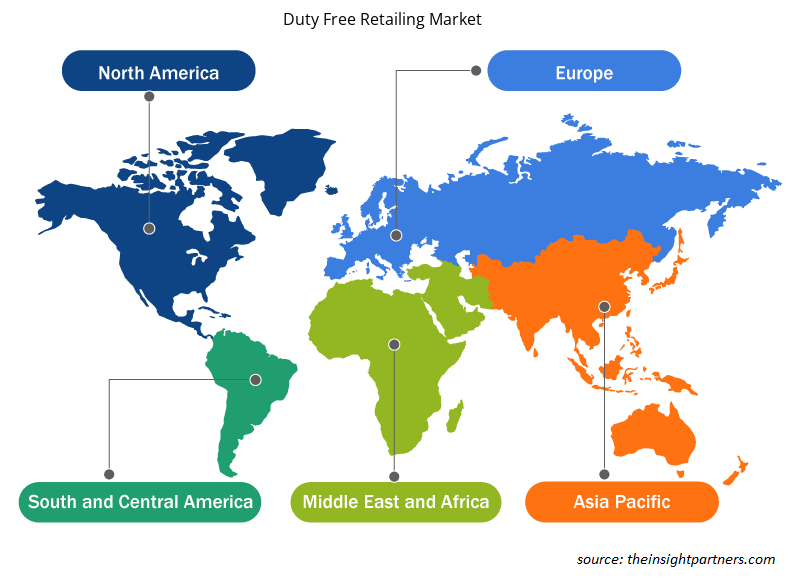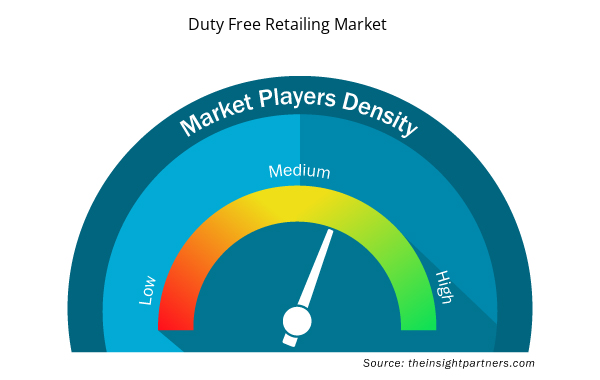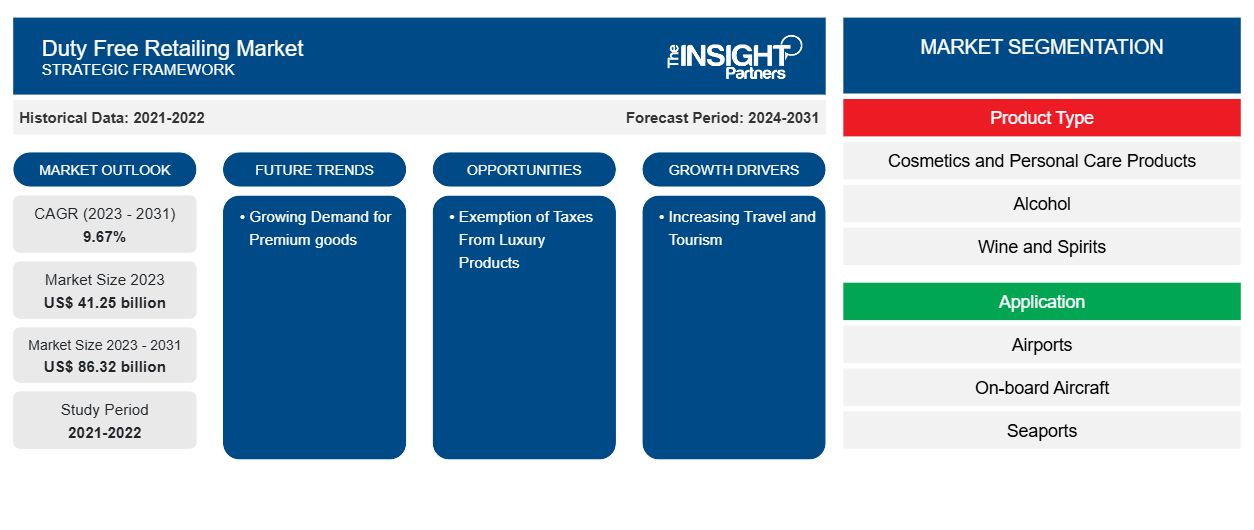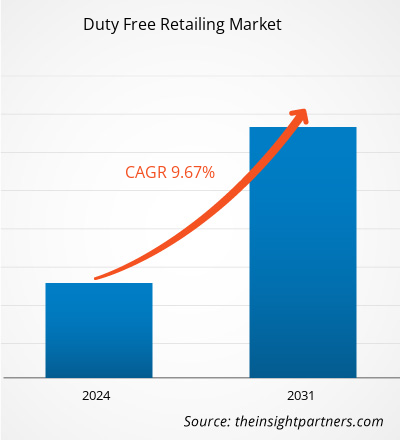免税零售市场规模预计将从 2023 年的 412.5 亿美元增至 2031 年的 863.2 亿美元。免税零售市场预计在 2023-2031 年的复合年增长率为 9.67%。奢侈品和一站式购物的日益衰落。
免税零售市场分析
旅游业的投资和发展不断增长,加上酒店和基础设施等领域的整合以及政府的支持,推动了旅游业的发展,从而促进了免税零售市场的增长。
免税零售市场概况
免税零售店是指免税商品免征某些国家和地方税的商店;与普通零售店相比,免税商品的价格更低。免税零售店让旅客有机会在各种产品上省钱,例如酒类、香水、烟草、化妆品、电子产品等。节省的钱可能很可观,尤其是高价奢侈品。这些免税店位于国际机场航站楼内的战略位置,方便从其他国家出发或抵达的旅客到达。因此,如果乘客需要购买旅途中可能需要的物品或为亲朋好友购买纪念品和礼物,他们可以轻松地在这些免税店买到。
定制此报告以满足您的需求
您可以免费定制任何报告,包括本报告的部分内容、国家级分析、Excel 数据包,以及为初创企业和大学提供优惠和折扣
- 获取此报告的关键市场趋势。这个免费样品将包括数据分析,从市场趋势到估计和预测。
免税零售市场的驱动因素和机遇
免税奢侈品利好市场
免税商品使消费者能够以免税价格购买奢侈品和高端商品。由于生活方式繁忙,消费者更喜欢一站式购物,这种免税零售可以帮助他们购买更好的奢侈品。香水、手表、雪茄、高档酒类、时尚珠宝等奢侈品是免税店中最具吸引力的商品,价格更便宜,吸引了消费者。此外,各国都在开设免税奢侈品零售店。例如,2021 年 11 月,免税奢侈品店 Louis Vuitton 在海南的奢侈品岛中心开业。因此,对免税奢侈品的这种倾向推动了免税零售市场的增长。
旅游业增长
根据联合国世界贸易组织 (UNWTO) 今年发布的首份世界旅游晴雨表,2023 年底国际旅游业发展率为 88%,国际游客人数估计为 13 亿。最新的 UNWTO 世界旅游晴雨表全面概述了该行业在 2023 年的表现,追踪了全球地区、次区域和目的地的复苏情况。初步估计,2023 年国际旅游收入达到 1.4 万亿美元。此外,由于签证便利化和航空运力提高,预计 2024 年中国出境和入境旅游将加速发展。中国正在为法国、意大利、德国、荷兰、西班牙和马来西亚公民申请免签证旅行,有效期为一年,直至2024年11月30日。预计欧洲将在2024年再次取得成果。今年3月,罗马尼亚和保加利亚加入了自由流动的申根区,巴黎将于2024年7月和8月举办夏季奥运会。这些有利于增加旅行和旅游业的措施将增加国际旅行,这将为免税零售市场的增长创造机会。
免税零售市场报告细分分析
有助于免税零售市场分析的关键部分是产品类型和应用。
- 根据产品类型,免税零售市场分为化妆品和个人护理产品、酒精、葡萄酒和烈酒、烟草和香烟、时装、糖果和食品等。
- 根据应用,免税零售市场分为机场、机上、海港和其他。
免税零售市场份额按地区分析
免税零售市场报告的地理范围主要分为五个地区:北美、亚太、欧洲、中东和非洲以及南美/南美和中美。随着旅行和旅游业的增加以及机场基础设施的增长,全球免税零售业也随之增长。2023 年 8 月,国际机场理事会 (ACI) 世界预测 2022 年至 2040 年期间客运量年均增长率为 5.8%。到 2040 年,每年将有超过 190 亿乘客通过全球机场出行。2023 年 11 月,国际机场理事会报告称,亚太地区具有巨大的航空潜力,因为全球 300 个计划中的机场中有 57% 都位于该地区。因此,机场和客流量的这种增长为免税零售市场的增长创造了有利可图的机会。
免税零售市场区域洞察
Insight Partners 的分析师已详尽解释了预测期内影响免税零售市场的区域趋势和因素。本节还讨论了北美、欧洲、亚太地区、中东和非洲以及南美和中美洲的免税零售市场细分和地理位置。

- 获取免税零售市场的区域特定数据
免税零售市场报告范围
| 报告属性 | 细节 |
|---|---|
| 2023 年的市场规模 | 412.5亿美元 |
| 2031 年市场规模 | 863.2亿美元 |
| 全球复合年增长率(2023 - 2031) | 9.67% |
| 史料 | 2021-2022 |
| 预测期 | 2024-2031 |
| 涵盖的领域 | 按产品类型
|
| 覆盖地区和国家 | 北美
|
| 市场领导者和主要公司简介 |
|
免税零售市场参与者密度:了解其对商业动态的影响
免税零售市场正在快速增长,这得益于终端用户需求的不断增长,而这些需求又源于消费者偏好的不断变化、技术进步以及对产品优势的认识不断提高等因素。随着需求的增加,企业正在扩大其产品范围,进行创新以满足消费者的需求,并利用新兴趋势,从而进一步推动市场增长。
市场参与者密度是指在特定市场或行业内运营的企业或公司的分布情况。它表明在给定市场空间中,相对于其规模或总市场价值,有多少竞争对手(市场参与者)存在。
在免税零售市场运营的主要公司有:
- 里亚安塔国际航空 (ARI)
- 中国免税品集团有限公司
- 迪拜免税店
- 美洲免税店
- 海涅曼兄弟
- 王权国际集团
免责声明:上面列出的公司没有按照任何特定顺序排列。

- 获取免税零售市场顶级关键参与者的概览
免税零售市场新闻和最新发展
免税零售市场通过收集一手和二手研究后的定性和定量数据进行评估,其中包括重要的公司出版物、协会数据和数据库。以下是市场发展情况的列表:
- 2024 年 3 月,孟买旅游零售私人有限公司 (MTRPL) 宣布更名为 OSPREE。新的品牌标识“Ospree”是 MTRPL 整合其所有免税资产的战略,包括孟买、阿姆利则、勒克瑙、特里凡得琅、斋浦尔、艾哈迈达巴德和芒格洛尔。
(来源:孟买旅游零售私人有限公司,新闻稿,2024 年)
- 2024 年 1 月,孟买免税店宣布在贾特拉帕蒂·希瓦吉·马哈拉杰国际机场出发大厅开设一家 Nappa Dori 商店,标志着该品牌进军旅游零售领域。Nappa Dori 的意思是皮革和线,是一个印度品牌,以手工制作的皮革制品和配饰而闻名。
(来源:孟买免税店,新闻稿,2024 年)
免税零售市场报告范围和交付成果
“免税零售市场规模和预测(2021-2031)”报告对市场进行了详细的分析,涵盖以下领域:
- 范围内所有主要细分市场的全球、区域和国家层面的市场规模和预测
- 市场动态,如驱动因素、限制因素和关键机遇
- 未来的主要趋势
- 详细的 PEST/波特五力分析和 SWOT 分析
- 全球和区域市场分析涵盖关键市场趋势、主要参与者、法规和最新市场发展
- 行业格局和竞争分析,涵盖市场集中度、热点图分析、知名参与者和最新发展
- 详细的公司简介
- 历史分析(2 年)、基准年、预测(7 年)及复合年增长率
- PEST 和 SWOT 分析
- 市场规模价值/数量 - 全球、区域、国家
- 行业和竞争格局
- Excel 数据集


- Medical Enzyme Technology Market
- Semiconductor Metrology and Inspection Market
- Biopharmaceutical Tubing Market
- Hydrogen Storage Alloys Market
- Legal Case Management Software Market
- Medical Audiometer Devices Market
- Hair Extensions Market
- Sexual Wellness Market
- Sports Technology Market
- Architecture Software Market

Report Coverage
Revenue forecast, Company Analysis, Industry landscape, Growth factors, and Trends

Segment Covered
This text is related
to segments covered.

Regional Scope
North America, Europe, Asia Pacific, Middle East & Africa, South & Central America

Country Scope
This text is related
to country scope.
常见问题
The global duty free retailing market was estimated to be US$ 41.25 billion in 2023 and is expected to grow at a CAGR of 9.67% during the forecast period 2023 - 2031.
Exemption of taxes from luxury products is the major factors that propel the global duty free retailing market.
Growing demand for premium goods is anticipated to play a significant role in the global duty free retailing market in the coming years.
The key players holding majority shares in the global duty free retailing market Aer Rianta International (ARI), China Duty Free Group Co., Ltd., Dubai Duty Free, Duty Free Americas, and Gebr. Heinemann.
The global duty free retailing market is expected to reach US$ 86.32 billion by 2031.
Trends and growth analysis reports related to Technology, Media and Telecommunications : READ MORE..
The Insight Partners performs research in 4 major stages: Data Collection & Secondary Research, Primary Research, Data Analysis and Data Triangulation & Final Review.
- Data Collection and Secondary Research:
As a market research and consulting firm operating from a decade, we have published and advised several client across the globe. First step for any study will start with an assessment of currently available data and insights from existing reports. Further, historical and current market information is collected from Investor Presentations, Annual Reports, SEC Filings, etc., and other information related to company’s performance and market positioning are gathered from Paid Databases (Factiva, Hoovers, and Reuters) and various other publications available in public domain.
Several associations trade associates, technical forums, institutes, societies and organization are accessed to gain technical as well as market related insights through their publications such as research papers, blogs and press releases related to the studies are referred to get cues about the market. Further, white papers, journals, magazines, and other news articles published in last 3 years are scrutinized and analyzed to understand the current market trends.
- Primary Research:
The primarily interview analysis comprise of data obtained from industry participants interview and answers to survey questions gathered by in-house primary team.
For primary research, interviews are conducted with industry experts/CEOs/Marketing Managers/VPs/Subject Matter Experts from both demand and supply side to get a 360-degree view of the market. The primary team conducts several interviews based on the complexity of the markets to understand the various market trends and dynamics which makes research more credible and precise.
A typical research interview fulfils the following functions:
- Provides first-hand information on the market size, market trends, growth trends, competitive landscape, and outlook
- Validates and strengthens in-house secondary research findings
- Develops the analysis team’s expertise and market understanding
Primary research involves email interactions and telephone interviews for each market, category, segment, and sub-segment across geographies. The participants who typically take part in such a process include, but are not limited to:
- Industry participants: VPs, business development managers, market intelligence managers and national sales managers
- Outside experts: Valuation experts, research analysts and key opinion leaders specializing in the electronics and semiconductor industry.
Below is the breakup of our primary respondents by company, designation, and region:

Once we receive the confirmation from primary research sources or primary respondents, we finalize the base year market estimation and forecast the data as per the macroeconomic and microeconomic factors assessed during data collection.
- Data Analysis:
Once data is validated through both secondary as well as primary respondents, we finalize the market estimations by hypothesis formulation and factor analysis at regional and country level.
- Macro-Economic Factor Analysis:
We analyse macroeconomic indicators such the gross domestic product (GDP), increase in the demand for goods and services across industries, technological advancement, regional economic growth, governmental policies, the influence of COVID-19, PEST analysis, and other aspects. This analysis aids in setting benchmarks for various nations/regions and approximating market splits. Additionally, the general trend of the aforementioned components aid in determining the market's development possibilities.
- Country Level Data:
Various factors that are especially aligned to the country are taken into account to determine the market size for a certain area and country, including the presence of vendors, such as headquarters and offices, the country's GDP, demand patterns, and industry growth. To comprehend the market dynamics for the nation, a number of growth variables, inhibitors, application areas, and current market trends are researched. The aforementioned elements aid in determining the country's overall market's growth potential.
- Company Profile:
The “Table of Contents” is formulated by listing and analyzing more than 25 - 30 companies operating in the market ecosystem across geographies. However, we profile only 10 companies as a standard practice in our syndicate reports. These 10 companies comprise leading, emerging, and regional players. Nonetheless, our analysis is not restricted to the 10 listed companies, we also analyze other companies present in the market to develop a holistic view and understand the prevailing trends. The “Company Profiles” section in the report covers key facts, business description, products & services, financial information, SWOT analysis, and key developments. The financial information presented is extracted from the annual reports and official documents of the publicly listed companies. Upon collecting the information for the sections of respective companies, we verify them via various primary sources and then compile the data in respective company profiles. The company level information helps us in deriving the base number as well as in forecasting the market size.
- Developing Base Number:
Aggregation of sales statistics (2020-2022) and macro-economic factor, and other secondary and primary research insights are utilized to arrive at base number and related market shares for 2022. The data gaps are identified in this step and relevant market data is analyzed, collected from paid primary interviews or databases. On finalizing the base year market size, forecasts are developed on the basis of macro-economic, industry and market growth factors and company level analysis.
- Data Triangulation and Final Review:
The market findings and base year market size calculations are validated from supply as well as demand side. Demand side validations are based on macro-economic factor analysis and benchmarks for respective regions and countries. In case of supply side validations, revenues of major companies are estimated (in case not available) based on industry benchmark, approximate number of employees, product portfolio, and primary interviews revenues are gathered. Further revenue from target product/service segment is assessed to avoid overshooting of market statistics. In case of heavy deviations between supply and demand side values, all thes steps are repeated to achieve synchronization.
We follow an iterative model, wherein we share our research findings with Subject Matter Experts (SME’s) and Key Opinion Leaders (KOLs) until consensus view of the market is not formulated – this model negates any drastic deviation in the opinions of experts. Only validated and universally acceptable research findings are quoted in our reports.
We have important check points that we use to validate our research findings – which we call – data triangulation, where we validate the information, we generate from secondary sources with primary interviews and then we re-validate with our internal data bases and Subject matter experts. This comprehensive model enables us to deliver high quality, reliable data in shortest possible time.


 获取此报告的免费样本
获取此报告的免费样本